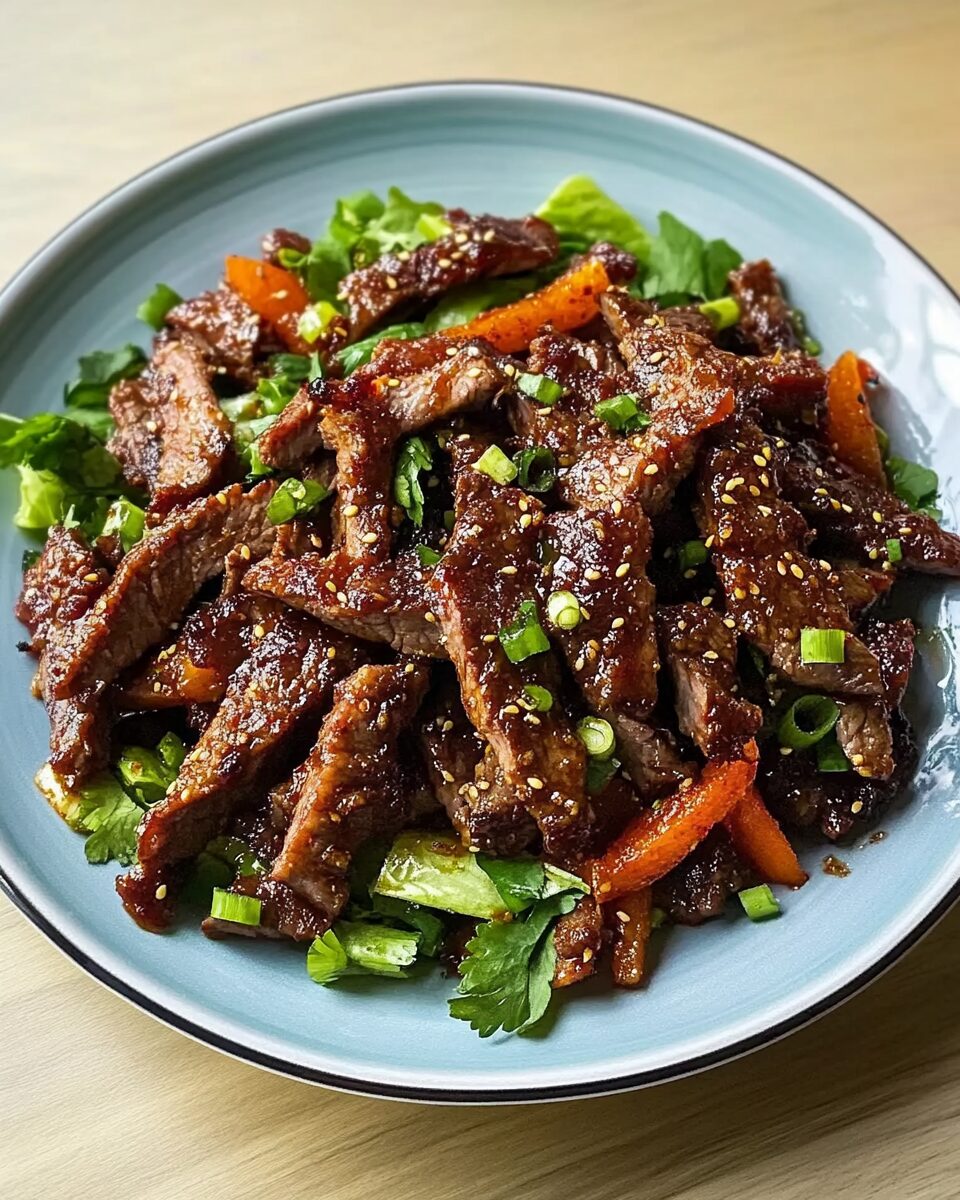Easy Bulgogi, a classic Korean BBQ dish, delivers rich umami with its tender, thin slices of beef marinated in a sweet and savory soy-based sauce. The caramelization from honey during cooking adds a beautiful glaze, and the red pepper flakes offer just the right touch of heat. It’s flavorful, filling, and so easy to prepare, making it a standout option for busy weeknights or weekend feasts.
Whether served over steamed rice, wrapped in lettuce, or paired with kimchi, this dish brings authentic Korean flavor right into your kitchen. The marinade works magic on the beef, infusing it with layers of garlic, sesame, ginger, and spice. You’ll love how quickly it comes together — and how fast it disappears from the plate.
Full Recipe:
-
1/2 cup soy sauce
-
4 green onions, chopped (white and light green parts for marinade, dark green parts for garnish)
-
1/2 yellow onion, finely chopped
-
2 tablespoons white sugar
-
4 cloves garlic, minced
-
2 tablespoons sesame seeds
-
2 tablespoons sesame oil
-
1 teaspoon red pepper flakes
-
1/2 teaspoon ground ginger
-
1/2 teaspoon ground black pepper
-
1 pound rib-eye steak, very thinly sliced
-
1 tablespoon honey
Directions:
-
In a large glass or ceramic bowl, whisk together soy sauce, chopped green onions (white and light green parts), yellow onion, sugar, garlic, sesame seeds, sesame oil, red pepper flakes, ginger, and black pepper.
-
Add the thinly sliced steak and toss until evenly coated with the marinade.
-
Cover the bowl with plastic wrap and refrigerate for at least 1 hour, up to 24 hours for maximum flavor.
-
Heat a wok or large skillet over medium heat.
-
Working in batches, cook the steak with some of the marinade in the hot skillet, stirring frequently.
-
Add honey to each batch to caramelize the meat slightly. Cook for about 5 minutes, or until the beef is fully cooked and slightly charred.
-
Garnish with the dark green parts of green onions before serving.
Prep Time: 15 minutes | Cooking Time: 10 minutes | Total Time: 25 minutes
Kcal: 310 kcal | Servings: 4 servings
What Is Bulgogi?
Bulgogi, which translates to “fire meat” in Korean, is one of Korea’s most iconic and beloved dishes. It traditionally features thin slices of marinated beef grilled or stir-fried over high heat. This dish dates back to the Goguryeo era (around 37 B.C. to 668 A.D.), where it was originally known as maekjeok, skewered and grilled over a flame. Over centuries, bulgogi evolved in cooking style and ingredients, becoming the soy-marinated, savory-sweet delicacy that we know and love today.
In modern Korean cuisine, bulgogi is not just a staple meal — it’s a centerpiece of celebration and family gatherings. Whether served in upscale restaurants or home kitchens, its tender, flavorful beef and aromatic marinade have made it a comfort food for many and a delicious introduction to Korean flavors for those around the world.
The Signature Flavor Profile of Bulgogi
What sets bulgogi apart is its marinade. A masterful balance of savory, sweet, garlicky, and umami flavors, the marinade penetrates the thin beef slices to tenderize and infuse them. The key components typically include soy sauce, sugar (or other sweeteners), garlic, sesame oil, and onion. Ginger and red pepper flakes are often added for complexity, while sesame seeds bring a subtle nuttiness.
The result? A luscious, melt-in-your-mouth beef dish that’s slightly caramelized on the outside and bursting with juicy, savory-sweet goodness on the inside. This combination of bold and balanced flavors makes bulgogi appealing to both new and seasoned palates. Unlike spicier Korean dishes like kimchi jjigae or dak galbi, bulgogi tends to be milder and more kid-friendly, though you can always amp up the heat to taste.
Why This Easy Bulgogi Recipe Works
What makes the “Easy Bulgogi” version stand out is its accessibility. Many people shy away from Korean recipes thinking they’ll require specialty ingredients or complex techniques. But this recipe simplifies everything. It uses ingredients commonly found in most pantries or local grocery stores while preserving the integrity of authentic Korean flavor.
Moreover, the quick marination and high-heat cooking technique make it perfect for weeknight dinners. The use of honey as a caramelizing agent during the stir-frying stage is a clever twist, adding richness and a subtle sheen to the cooked beef. This technique mimics the slight char achieved from traditional grilling, even when using a regular stovetop.
Best Cuts of Beef for Bulgogi
Although this recipe uses rib-eye steak — an excellent choice due to its marbling and tenderness — other cuts like sirloin, tenderloin, or even brisket can be used. The key is slicing the meat very thinly, ideally against the grain, to ensure maximum tenderness.
Freezing the beef for about 30 minutes before slicing is a useful tip that helps you achieve uniform, paper-thin slices, which is essential for proper marination and quick cooking. Whether you’re using premium beef or more budget-friendly cuts, the marinade does a phenomenal job of tenderizing and flavoring the meat.
How to Serve Bulgogi
Bulgogi is incredibly versatile in how it’s served. In Korea, it is often enjoyed with a bowl of freshly steamed white rice, along with side dishes called banchan, including kimchi, seasoned bean sprouts (kongnamul), and pickled radishes.
One popular way to eat bulgogi is wrapped in lettuce leaves (ssam), often with a dab of ssamjang (a spicy fermented bean paste), garlic slices, and green chili. This makes for a refreshing, crunchy, and spicy bite that contrasts beautifully with the warm, savory meat.
Bulgogi can also be used creatively in fusion dishes:
-
As a taco filling with slaw and spicy mayo
-
Topped over noodles or pasta
-
Layered in sandwiches or sliders
-
Even added to pizza or savory pancakes
This flexibility makes bulgogi a crowd-pleaser, great for gatherings, potlucks, or easy meal prep throughout the week.
Cultural Significance in Korean Cuisine
In Korean culture, bulgogi is more than just a delicious meal — it’s a dish that carries emotional and cultural weight. It’s a food associated with family, celebration, and hospitality. Often served during birthdays, holidays like Chuseok (Korean Thanksgiving), or formal dinners, bulgogi is seen as a way to honor guests and express care through food.
Korean cuisine places great value on balance — of flavors, colors, and textures. Bulgogi fits this philosophy perfectly. It offers sweetness from sugar and onions, saltiness from soy sauce, heat from pepper flakes, and the aromatic warmth of garlic and sesame. Combined with rice and sides, it creates a harmonious, well-rounded meal that satisfies both body and soul.
Pairings and Accompaniments
To turn bulgogi into a complete meal, pair it with simple sides that complement its flavor profile:
-
Kimchi: The fermented tang of kimchi contrasts beautifully with the savory sweetness of bulgogi.
-
Miso or Doenjang Soup: A warm bowl of soybean paste soup adds umami depth to the meal.
-
Japchae: Sweet potato noodles stir-fried with vegetables provide a hearty, chewy counterpart.
-
Pickled Veggies: Radish or cucumber pickles cut through the richness of the beef with refreshing acidity.
Drinks that go well with bulgogi include light-bodied beers, soju, or makgeolli (Korean rice wine). For a non-alcoholic option, try cold barley tea or sparkling water with lemon.
Tips for Success and Customization
Here are a few insider tips to ensure your bulgogi turns out perfectly every time:
-
Marinate Overnight for Best Results: Though this recipe only requires an hour of marination, longer is better. Marinating overnight will deepen the flavor and improve tenderness.
-
Don’t Overcrowd the Pan: Cook the beef in batches. Overcrowding causes the meat to steam rather than sear, preventing caramelization.
-
Use Cast Iron or Wok for Best Texture: A heavy pan that holds heat well ensures a nice char on the meat.
-
Vegetable Add-Ins: You can bulk up your bulgogi with mushrooms, carrots, zucchini, or bell peppers. Just slice them thin so they cook quickly.
You can also make it vegan or vegetarian by replacing the beef with tofu, tempeh, or mushrooms like king oyster or portobello. The marinade works beautifully on plant-based proteins as well.
Why You Should Add Bulgogi to Your Weekly Rotation
Easy Bulgogi isn’t just a Korean dish — it’s an experience. The aroma alone while it’s cooking can make your mouth water. It’s packed with flavor, quick to prepare, and adaptable to various diets and preferences. Once you try it, it’s almost certain to become a regular on your meal plan.
The simplicity of the recipe allows even beginner cooks to achieve great results, while the depth of flavor satisfies more advanced culinary palates. It’s a perfect entry point into Korean cuisine and a gateway to exploring other dishes like bibimbap, samgyeopsal, or tteokbokki.
Conclusion
Bulgogi is a culinary treasure that showcases the soul of Korean cuisine. Its irresistible balance of sweet, savory, and spicy notes, combined with tender, juicy beef, makes it universally loved and widely replicated. Whether you’re preparing it for the first time or have been enjoying it for years, this dish continues to impress with its depth of flavor and cultural richness.
With the Easy Bulgogi recipe, you get all the complex tastes of traditional Korean BBQ in a simplified format that suits modern lifestyles. It’s a dish that brings warmth to the table, invites conversation, and leaves everyone satisfied — just as any great meal should.
If you’re looking to elevate your dinner repertoire, impress your guests, or simply treat yourself to something delicious, bulgogi is an unbeatable choice. Try it once, and it might just become your new favorite comfort food.








